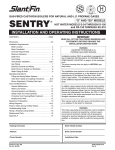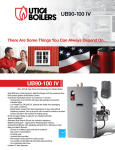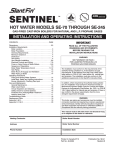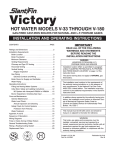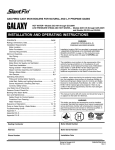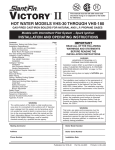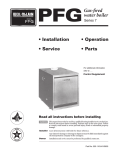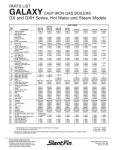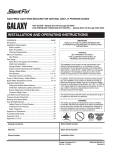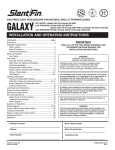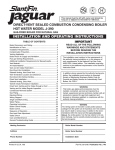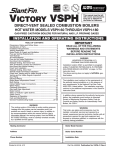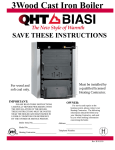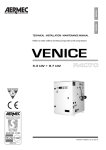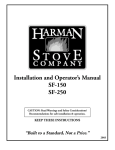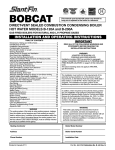Download Sentry S-120-EDP Installation Guide
Transcript
GAS-FIRED CAST-IRON BOILERS FOR NATURAL AND L.P. PROPANE GASES SENTRY ® This manual must be left with owner and should be hung on or adjacent to the boiler for reference. HOT WATER MODELS S-34 THROUGH S-150 INSTALLATION AND OPERATING INSTRUCTIONS CONTENTS. . . . . . . . . . . . . . . . . . . . . . . . . . . . . . . . PAGE IMPORTANT Dimensions . . . . . . . . . . . . . . . . . . . . . . . . . . . . . . . . . . 2,3 Installation Requirements: Boiler Location . . . . . . . . . . . . . . . . . . . . . . . . . . . . . . . 3 Boiler Foundation . . . . . . . . . . . . . . . . . . . . . . . . . . . . . 3 Chimney Requirements . . . . . . . . . . . . . . . . . . . . . . . . 4 Minimum Clearance . . . . . . . . . . . . . . . . . . . . . . . . . . . 4 Vent Piping . . . . . . . . . . . . . . . . . . . . . . . . . . . . . . . . . . 4 Vent Damper Installation . . . . . . . . . . . . . . . . . . . . . . . 5 Gas Piping . . . . . . . . . . . . . . . . . . . . . . . . . . . . . . . . . . 6 Electrical Controls and Wiring. . . . . . . . . . . . . . . . . 6-10 Boiler Water Temperature Control. . . . . . . . . . . . . 10-15 Sequence of Operation . . . . . . . . . . . . . . . . . . . . . . . 16 Boiler Room Air Supply and Ventilation . . . . . . . . . . . 17 Water Piping at Boiler . . . . . . . . . . . . . . . . . . . . . . . . 17 Operating Instructions: Filling and Venting Water Systems. . . . . . . . . . . . . . . 17 Initial Start: Safety Information and Lighting Instruction . . . . . . . . 20 Burner Adjustment, Checking Gas Input . . . . . . . 20-21 Care and Maintenance General Maintenance. . . . . . . . . . . . . . . . . . . . . . . . . 21 Water Level Check . . . . . . . . . . . . . . . . . . . . . . . . . . . 22 Annual Inspection and Cleaning . . . . . . . . . . . . . . . . 22 Safety Check for Control Systems . . . . . . . . . . . . . . . 22 Protection from Freezing/Water Treatment. . . . . . . . . 22 Keeping Area Clear . . . . . . . . . . . . . . . . . . . . . . . . . . 22 Troubleshooting Guide . . . . . . . . . . . . . . . . . . . . . . . . . . 23 Piping a Heating-Cooling System . . . . . . . . . . . . . . . . . . 24 Replacement Parts . . . . . . . . . . . . . . . . . . . . . . . . . . . . . 24 Appendix A . . . . . . . . . . . . . . . . . . . . . . . . . . . . . . . . . . . 25 READ ALL OF THE FOLLOWING WARNINGS AND STATEMENTS BEFORE READING THE INSTALLATION INSTRUCTIONS WARNING SEE “WARNING” ON PAGE 4 FOR LIQUEFIED PETROLEUM (L.P.) PROPANE GAS-FIRED BOILERS The installation must conform to the requirements of the authority having jurisdiction or, in the absence of such requirements, to the National Fuel Gas Code, ANSI Z223.1latest edition. The installation must also conform to the additional requirements in this Slant/Fin Instruction Book. In addition, where required by the authority having jurisdiction, the installation must conform to American Society of Mechanical Engineers Safety Code for Controls and Safety Devices for Automatically Fired Boilers, No. CSD-1. If there is any conflict in the above requirements, then the more stringent requirement will apply. This manual must be left with owner and should be hung on or adjacent to the boiler for reference. WARNING This boiler, gas piping and accessories must be installed, connected, serviced and repaired by a trained, experienced service technician, familiar with all precautions required for gas-fired equipment and licensed otherwise qualified, in compliance with the authority having jurisdiction. Heating Contractor Boiler Model Number Address Boiler Serial Number Phone Number Installation Date Printed in U.S.A. 414 Part No. 46-0602 PUBLICATION S-41 Rev.C Sentry 2 Note: Height dimension increases by 1-3/4" when comustible floor kit is used. * Vent damper may be installed horizontally on all models with use of a vent elbow. For more information, see figure 2, page 5. Sentry 3 Dimensions (inches) Boiler Model No. of Sect. A B C D E F G (max) S-34 S-60 S-90 S-120 S-150 2 3 4 5 6 81⁄8" 111⁄8" 141⁄8" 171⁄8" 201⁄8" 145⁄8" 175⁄8" 205⁄8" 235⁄8" 265⁄8" 4 4 5 6 7 33" 37" 37" 37" 37" — 41⁄2" 51⁄2" 71⁄2" 81⁄2" — 26" 251⁄2" 25" 241⁄2" 61⁄4" 61⁄4" 61⁄4" 61⁄4" 81⁄4" Boiler Model Gas Type S-34 Natural Propane S-60 thru S-150 Natural Propane Orifice Size for Sea Level Approx. Total Wt. Full of Water (lb.) 190 250 310 365 425 CHIMNEY RECOMMENDATIONS HEIGHT:15 ft. (minimum) from draft hood skirt to top of chimney. INSIDE DIAMETER: Same as dimension C (or larger). NOTE: Larger chimney may be required if two or more boilers or a boiler and another appliance are vented to a single chimney. Slant/Fin supplies vent dampers by several manufacturers. Some are smaller than the indicated “G maximum”. Orifice Sizes for High Altitudes Includes 4% Reduction for Each 1000 Feet Elevation - Feet 2000 3000 4000 5000 6000 7000 8000 9000 10000 47 56 48 56 48 56 49 57 49 57 49 57 50 58 50 59 51 59 51 60 50 57 51 58 51 59 51 59 51 60 52 60 52 61 52 62 53 63 53 63 Orifice indicated for sea level above are factory installed in boiler unless otherwise specified by the local authority. See page 20 for burner input adjustment. INSTALLATION REQUIREMENTS Base Assembly Sentry Boiler The installation must conform to the requirements of the authority having jurisdiction or, in the absence of such requirements, to the National Fuel Gas Code, ANSI Z223.1-latest edition. This installation must also conform to the additional requirements in this Slant/Fin Instruction Book. Burners Pilot Burner Access Door Gas Valve NATURAL GAS-FIRED BOILER LOCATION Provide a level, solid foundation for the boiler. Location should be as near as possible to chimney or outside wall so that the flue pipe from boiler is short and direct. The location should also be such that the gas ignition system components are protected from water (dripping, spraying, rain, etc.) during appliance operation and service (circulator replacement, condensate trap, control replacement, etc.). BOILER FOUNDATION A. Provide a solid, level foundation, capable of supporting the weight of the boiler filled with water, and extending at least 2" past the jacket on all sides. See dimensions of boiler, page 2. B. For installation on non-combustible floors only. The Combustible Floor Kit part number printed on the boiler rating plate is the only one to be used when installing on combustible floors. The boiler must not be installed on carpeting. C. If boiler is to be located over buried conduit containing electric wires or telephone cables, consult local codes or the National Board of Fire Underwriters for specific requirements. Sentry 4 WARNING SPECIAL ATTENTION FOR LIQUEFIED PETROLEUM (L.P.) PROPANE GAS-FIRED BOILER INSTALLATIONS LPG appliances (boilers) shall be installed in accordance with applicable provisions of NFPA 58 ( Liquefied Petroleum Gas Code) latest edition for installations in US and CAN/CGA B149.1 latest edition for installations in Canada. Liquefied Petroleum (LP) propane gas is heavier than air therefore Propane gas accumulate at floor level. If you suspect a leak, do not attempt to operate boiler. A spark or flame from the appliance (boiler) or other sources may ignite the accumulated propane gas causing an explosion or fire. It is recommended that inspections for gas leaks be performed periodically by licensed professional and that leak detection devices be installed as a further safety measure. CHIMNEY REQUIREMENTS A. Sentry boilers may be vented into a masonry vitreous tilelined chimney or type “B” venting system NOT EXPOSED to the OUTDOORS below the roof line. Venting and sizing of venting system must be in accordance with National Fuel Gas Code ANSI Z223.1, NFPA 54, -latest edition which will be referred to as the National Fuel Gas Code. Local codes apply. If a masonry chimney is exposed to the outdoors on one or more sides below the roof line (exterior chimney), ONE of the following options apply: 1. Chimney must be re-lined with a metallic liner. When this is done, the chimney will be considered NOT exposed to the outdoors and the requirements of the National Fuel Gas Code for NON-exposed chimneys and/or local codes will apply. 2. If an exposed tile-lined chimney is to be used WITHOUT a metallic liner, the boiler must first meet the requirements of the National Fuel Gas Code. B. If an existing boiler is removed from a common venting system, the common venting system may be too large for proper venting of the remaining appliances connected to the common vent. Follow the test procedure shown in Appendix “A” of this manual to insure proper operation of venting system and appliances. C. Inspect for proper and tight construction. Any restrictions or obstructions must be removed. An existing chimney may require cleaning. D. Chimney or vent must extend at least 3 feet above any ridge within 10 feet of the chimney. MINIMUM CLEARANCES FROM COMBUSTIBLE CONSTRUCTIONS A. Minimum boiler clearances shall be as follows: SENTRY SERIES MINIMUM CLEARANCE FOR COMBUSTIBLE CONSTRUCTION. MINIMUM ALCOVE AND CLOSET CLEARANCE. Front Rear Left Side Right Side Top (above boiler) Flue Connector S-34 through S-150 6" 6" 6" 12" 12" 6" B. Provide accessibility clearance of 24” on sides requiring servicing and 18” on sides used for passage. C. All minimum clearances shown above must be met. This may result in increased values of some minimum clearances in order to maintain the minimum clearances of others. D. Clearance from hot water pipes shall be 1 inch**. ** At points where hot water pipes emerge from a floor wall or ceiling, the clearance at the opening through the finished floor, wall or ceiling boards may not be less than 1/2 inch. Each such opening shall be covered with a plate of non-combustible material. SAFETY— KEEP THE BOILER AREA CLEAR AND FREE FROM COMBUSTIBLE MATERIALS, GASOLINE AND OTHER FLAMMABLE VAPORS AND LIQUIDS. VENT PIPING— A. Vent piping installation must be in accordance with ANSI Z223.1-latest edition, National Fuel Gas Code, Venting of Equipment. Other local codes may also apply and must be followed. B. Boiler vent pipe must be the full diameter of the boiler outlet. See dimensions, page 2. C. If more than one appliance vents into a common breeching, the area of the breeching must be equal to the area of the largest vent plus 50% of the area of the additional vent areas. Vent connectors serving appliances vented by natural draft shall not be connected into any portion of mechanical draft systems operating under positive pressure. Horizontal breeching or vent pipe should be as high as possible, consistent with codes, so that vertical vents from appliances will have a high rise above draft diverter openings. All horizontal runs must slope upwards not less than 1/4 inch per foot of run. Horizontal portions of the venting system must be supported to prevent sagging by securing each joint with metal screws and by providing hanger spaced no greater than 5 feet apart. Sentry 5 D. Vent or breeching into chimney should not be inserted past the inside wall of the chimney liner. E. All venting means should be inspected frequently. See Care and Maintenance and separate User's Information Manual. VENT DAMPER INSTALLATION The vent damper referred to in the following instructions is the Slant/Fin Corporation vent damper. This device is design certified by A.G.A. for use ONLY on specific Slant/Fin Corp. gas boiler models. These boilers must also be equipped with a plate which states that the boiler may be used with a Slant/Fin Corp. automatic vent damper device and indicates the proper vent damper model number. A. INSTALLATION INSTRUCTIONS BEFORE YOU START TO INSTALL 1. Read this installation manual, the "DANGER" plate attached to the top of the boiler, the "WARNING" on the wiring diagrams, vent damper carton and operator cover. 2. Perform pre-installation inspection as required by ANSI specification Z21.66. (See Vent Damper Instructions.) 3. Select a proper, convenient location for vent damper. Vent damper may be installed vertical or horizontal on all models (see figures 1 and 2). 4. Carefully unpack the unit. DO NOT FORCE IT OPEN OR CLOSED. Forcing the damper may damage the gear train and void the warranty. B. 1. This device must be installed after the boiler draft hood (between the draft hood outlet and the connector to the outdoor chimney or vent) as close to the draft hood as practicable, and without modification of the draft hood or the vent damper. (See figures 1, 2 and 3.) 2. The inlet size of the vent damper must be the same nominal trade size as the outlet of the draft hood. 3. This device must be located in a venting system or section of a venting system so that it serves only the single appliance for which it is installed. (See figure 3.) 4. Clearances of not less than 6 inches (152MM) must be maintained from combustible materials, with provisions for service access. C. AFTER INSTALLATION: 1. Operate system through two complete cycles to check for opening and closing in proper sequence, and proper burner operation. DAMPER MUST BE IN OPEN POSITION WHEN BOILER MAIN BURNERS ARE OPERATING. 2. Perform installation checks as required by ANSI specification Z21.66. (See Vent Damper Instructions.) 3. Check the troubleshooting section if problems arise with the installation. Figure 3. Figure 1. Vertical Installation of Vent Damper on Sentry “S” Boilers Figure 2. Horizontal Installation of Vent Damper WARNING—DANGER Once you have begun vent damper installation procedure, DO NOT restore electric power and gas supply until installation and inspection have been completed (in order to prevent the main burners from operating). DO NOT operate the boiler until the vent damper harness is plugged into vent damper operator. Failure to observe this warning may create a hazardous condition that could cause an explosion or carbon monoxide poisoning. Sentry 6 GAS PIPING— A. Local installation codes apply. The pipe joint compound used on threads must be resistant to the action of liquefied petroleum gases. B. The gas supply line to the boiler should be run directly from the meter for natural gas or from the fuel tank for L.P. propane gas. See page 2 for location of union and manual main shutoff valve that may be specified locally. Selecting pipe size for natural gas: 1. Measure or estimate the length of piping from the meter to the installation site. 2. Consult gas supplier for heating value of gas (Btu/cu. ft.). 3. Divide boiler rated input by heating value to find gas flow in piping (cu. ft. per hour). 4. Use table A to select proper pipe size. Example: Boiler model S-150 is to be installed. Distance from gas meter to the boiler is 30 ft. Heating value of natural gas is 1020 Btu/cu. ft. Select proper pipe size. Gas flow = 150,000 Btu/hour = 147 cu. ft. per hour 1020 Btu/cu.ft. At 30 ft. length of pipe, match required capacity from Table A (choose higher capacity, in this case is 152 cu. ft. per hour). Required pipe size is 3/4". Improper gas pipe sizing will result in pilot flame outages, insufficient heat and other installation difficulties. For more information and also if other appliances are to be attached to the piping system, see Appendix C of National Fuel Gas Code ANSI Z223.1-latest edition. C. The boiler and its gas connection must be leak tested before placing the boiler in operation. Use liquid soap solution for all gas leak testing. DO NOT use open flame. This boiler and its individual shutoff valve must be disconnected from the gas supply piping system during any pressure testing of that system at test pressures in excess of 1/2 PSIG. This boiler must be isolated from the gas supply piping system by closing its individual manual shutoff valve during any pressure testing of the gas supply piping system at test pressures equal to or less than 1/2 PSIG. D. All gas piping used should be inspected thoroughly for cleanliness before makeup. A sediment trap must be provided, as illustrated on page 2. E. The minimum and maximum gas supply pressure (at the inlet of gas valve) are shown on the boiler rating plate for the type of gas used. Gas supply pressure should never be less than minimum or more than maximum pressure when the boiler or any other appliance is turned on or off. Length of Pipe in Feet 10 20 30 40 50 60 70 80 90 100 Gas Flow In Piping -- cu. ft. per hr. Iron Pipe Size (IPS)—inches 1/2 132 92 73 63 56 50 46 43 40 38 3/4 278 190 152 130 115 105 96 90 84 79 1 520 350 285 245 215 195 180 170 160 150 1-1/4 1050 730 590 500 440 400 370 350 320 305 1-1/2 1600 1100 890 760 670 610 560 530 490 460 At pressure drop of 0.3 in. water, specific gravity = 0.60. ELECTRICAL WIRING DANGER: Before wiring, always turn off electric power supply, otherwise, shock or death can result. 1. Power Supply A separately fused circuit is recommended. Use a standard 15 amp. fuse or breaker and 14 gage conductors in BX cable or conduit. Provide disconnect means and overload protection as required. See boiler wiring diagram (Figure 4). Boiler must be electrically grounded in accordance with the requirements of the authority having jurisdiction, or, in the absence of such requirements, with the National Electrical Code, ANSI/NFPA 70-latest edition. 2. Power Connection Connect hot and neutral to L1 and L2 terminal of the boiler control (See figure 4). Connect ground wire to ground screw inside boiler control. 3. Thermostat Connections Thermostat wire connections must be to T and TV screw terminals of boiler temperature control (See figure 4). Thermostat Heat Anticipator Adjustments If the 24V room thermostat that controls this boiler has an adjustable heat anticipator, connect entire system to thermostat and run the system while measuring the current drawn through the thermostat wires. Set the heat anticipator at the value measured. The set current should match power requirements by zone valves and relays. Add an additional 0.1 Amp to the measured current for vent dampers. Refer to the manufacturer’s instructions of zone valve, vent damper and relays. Also, see instructions with the thermostat. 4. Multi Zoning For pump zoning system, see figure 5 and 6 for zone valve system, see figure 7. DO NOT use control transformer to power external accessories like zone valve and relay, over load and/or burned-out transformer and boiler malfunction can result. 5. Indirect External Water Heater If the system includes indirect water heater, the indirect signal must be sepatayed from heating zone(s) system. See figure 6 and 8. Follow steps below: a. Connect end switch of the indirect water heater relay to I1 and I2 of the boiler temperature control. b. Connect end switch of the heating zones(s) relays to T and TV of the boiler temperature control. c. Power DHW and heating zone(s) circulators through end switch relays as shown on figure 6. Do not connect heating zone(s) circulators to C1 and C2 of the control. Note: For single heating zone with external indirect water heaters, see figure 9. Sentry 7 WIRING DIAGRAM FOR SENTRY(S) & SENTINEL(SE) BOILERS HYDROLEVEL HYDROSTAT CONTROL MODEL 3200 24V THERMOSTAT Z T TV ECONOMY LO TEMP HI TEMP PLUG VENT DAMPER HARNESS L1 L2 C2 C1 B1 B2 I1 I2 120V BLACK I NEUTRAL BLACK HOT WHITE GREEN HONEYWELL IGNITION MODULE WHITE 24V(GND) BLUE MV CIRCULATOR MV/PV 24V RED RED RED RED PV BLOCKED VENT SAFETY SWITCH ROLL-OUT SWITCH GND (BURNER) ELECTRIC IGNITION PILOT GREEN WIRE LEGEND: FACTORY WIRED FIELD WIRED, FIELD SUPPLIED I : PROVIDE DISCONNECT MEANS AND GAS VALVE IGNITER CABLE PILOT GAS PIPE OVERLOAD PROTECTION AS REQUIRED IF ANY OF THE ORIGINAL WIRE AS SUPPLIED WITH THE APPLIANCE MUST BE REPLACED. IT MUST BE REPLACED WITH TYP 105` OR ITS EQUIVALENT. BLK GND PV MV MV-PV WHITE RED CAUTION: LABEL ALL WIRE PRIOR TO DISCONNCTION WHEN SERVICING CONTROLS. WIRING ERRORS CAN CAUSE IMPROPER AND DANGEROUS OPERATION. "VERIFY PROPER OPERATION AFTER SERVICING". 46 1014 000 Figure 4. Sentry 8 Figure 5. Multizoning of Sentry boilers pump zoning system using R845A relay. Figure 6. Multizoning of Sentry boiler-2 zone system pump zoning system using R882A/B relays. Sentry Figure 7. Multizoning of Sentry boilers zone valve system using V8043E/F zone valves. Figure 8. Multizoning, zone valve system with indirect water heater (DHW Priority) using R882A/B relay. 9 10 Figure 9. Single zone with indirect water heater (DHW Priority) using R882A/B relay. Sentry Sentry 11 BOILERS EQUIPPED WITH HYDROSTAT CONTROL SETTING THE CONTROL NOTE: Settings can be checked using the TEST/SETTINGS Button. SETTING THE HIGH LIMIT The high limit is factory set at 190°F. To adjust, turn the HI TEMP Dial A until the desired setting is displayed. (Setting range: 100°-220°F) SETTING THE LOW LIMIT The low limit is designed to maintain temperature in boilers equipped with tankless coils used for domestic hot water. The low limit is factory set to OFF. Prior to adjusting, remove the jumper (not equipped on all units) B . Then turn the LO TEMP Dial C clockwise until the desired temperature is displayed. For proper operation, the low temperature limit setting should be at least 10° below the high limit setting. NOTE: For cold start operation, the low limit must be turned OFF. IMPORTANT: If low limit temperature cannot be set above 140°F, remove jumper B . (Setting range: OFF or 110°-200°F). SETTING THE ECONOMY FEATURE The Economy Feature is factory set for a 1 zone heating system. To adjust, turn the ECONOMY Dial D until the number displayed equals the number of heating zones. Do not include indirect water heaters in the number of heating zones. The Economy Feature conserves fuel by reducing boiler temperature (see “How Thermal Targeting Works” below). If the heating system is unable to supply needed heat to the house, the ECONOMY Dial should be turned to a lower setting (example: In a three zone house, turn the dial to 2 or 1). Conversely, if the boiler provides adequate heat, added fuel savings can be achieved by selecting a higher setting (example: 4 or 5). If the heating and indirect water heater signals were not separated when wiring the control, the Economy Feature should be turned OFF to insure the boiler supplies adequate temperature to heat the indirect tank. IMPORTANT NOTICE This boiler is equipped with a feature that saves energy by reducing the boiler water temperature as the heating load decreases. This feature is equipped with an override which is provided primarily to permit the use of an external energy management system that serves the same function. THIS OVERRIDE MUST NOT BE USED UNLESS AT LEAST ONE OF THE FOLLOWING CONDITIONS IS TRUE: • An external energy management system is installed that reduces the boiler water temperature as the heating load decreases. •This boiler is not used for any space heating. •This boiler has an input of 300,000 BTU/hr or greater • This boiler is part of a modular or multiple boiler system having a total input of 300,000 BTU/hr or greater. • This boiler is equipped with a tankless coil. SETTING OFF LO 1 2 3 4 5 HI Disables economy function. Will allow boiler to fire until hi limit temp is reached and re-fire with a 10° subtractive differential. Provides lowest level of fuel savings. Use this setting only if the house does not stay warm at higher settings. Recommended setting for single zone systems Recommended setting for Two zone systems Recommended setting for Three zone systems Recommended setting for Four zone systems Recommended setting for Five zone systems Provides highest level of fuel savings Sentry 12 OPTIONAL FEATURES NOTE: The Program Mode – Pro – is accessed by turning the LO TEMP dial to a position just above OFF. THERMAL PRE-PURGE Thermal Pre-Purge is designed to maximize boiler efficiency. When activated, the control will supply latent heat that may remain in the boiler from a previous run cycle to the next heating zone that calls. The control monitors how quickly the boiler temperature is declining and activates the burner only when it determines that the latent heat is insufficient to satisfy the call. During the purge cycle, the display will indicate Pur. This feature works with single-zone and multi-zone heating systems utilizing circulators or zone valves. No change in wiring is needed. To activate Thermal Pre-Purge 1. Turn the LO TEMP dial to access the Program Mode – indicated in the display as Pro 2. Turn the HI TEMP dial to select feature 1 3. Push the Test/Settings Button to turn Thermal Pre-Purge or OFF 4. Reset LO TEMP and HI TEMP settings to desired temperatures (see page 10) Note: Activation of this feature is not recommended for boilers with tankless coils. DEGREES FAHRENHEIT OR CELSIUS The control has the ability to operate in degrees Fahrenheit or Celsius. When operating in Celsius, a will appear in the display next to the temperature whenever the temperature is below 100 degrees. To change between degrees Fahrenheit and degrees Celsius 1. Turn the LO TEMP dial to access the Program Mode – indicated in the display as Pro 2. Turn the HI TEMP dial to select feature 2 3. Push the Test/Settings Button to c for Celsius or F for Fahrenheit 4. Reset LO TEMP and HI TEMP settings to desired temperatures (see page 10) MANUAL RESET LOW WATER CUT-OFF The low water cut-off operation on the HydroStat can be set to operate in automatic (default) or manual reset mode. When in manual reset mode, the control will shut-down the burner immediately when a low water condition is detected. If the low water condition is sustained for 30 seconds, the low water light will blink, indicating that the control has locked out the burner. The control can only be reset by pushing the Test Settings button on the top of the control. The manual reset feature meets CSD-1 code requirements. IMPORTANT: The system must be checked by a qualified heating professional prior to resuming operation. WARNING: DO NOT ADD WATER UNTIL THE BOILER HAS FULLY COOLED. To activate Manual Reset LWCO mode 1. Turn the LO TEMP dial to access the Program Mode – indicated in the display as Pro 2. Turn the HI TEMP dial to select feature 3 3. Push the Test/Settings Button to A for Automatic Reset Mode or b for Manual Reset Mode 4. Reset LO TEMP and HI TEMP settings to desired temperatures (see page 10) To Test the Manual Reset Feature: Press and hold the Test/Settings button located on the top of the control for 30 seconds to simulate a low water condition. After 30 seconds, the Low Water light will blink indicating that the control is locked out. To reset the lock-out condition, press the Test/Settings button momentarily. MORE OPTIONAL FEATURES ON NEXT PAGE Sentry 13 OPTIONAL FEATURES Continued CIRCULATOR ACTIVATION OPTIONS When in the default mode, the HydroStat activates the circulator (C1/C2 contacts) on calls to T/TV. The control can be programmed to activate the circulator on calls to I1/I2 in place of, or in addition to, calls to T/TV. To change how the Circulator is activated 1. Turn the LO TEMP dial to access the Program Mode – indicated in the display as Pro 2. Turn the HI TEMP dial to select feature 4 3. Push the Test/Settings Button to select between the following options: - Circulator on T/TV call only - Circulator on I1/I2 call only - Circulator on both T/TV & I1/I2 calls 4. Reset LO TEMP and HI TEMP settings to desired temperatures (see page 11 CIRCULATOR HOLD OFF (ENHANCED CONDENSING PROTECTION) To reduce the potential for condensing, on a call for heat the control will allow the boiler to heat to 125°F prior to energizing the circulator. Once energized, the circulator will remain on for the duration of the heating call unless the boiler temperature drops below 115°F. If this occurs, the circulator will re-energize when the boiler returns to 125°F. To activate Circulator Hold Off 1. Turn the LO TEMP dial to access the Program Mode – indicated in the display as Pro 2. Turn the HI TEMP dial to select feature 5 3. Push the Test/Settings Button to turn Circulator Hold Off or OFF 4. Reset LO TEMP and HI TEMP settings to desired temperatures (see page 11 LOW WATER CUT-OFF FUNCTION To turn off Low Water Cut-Off 1. Turn the LO TEMP dial to access the Program Mode – indicated in the display as Pro 2. Turn the HI TEMP dial to select feature 8 3. Push the Test/Settings Button to turn Low Water Cut-Off or OFF 4. Reset LO TEMP and HI TEMP settings to desired temperatures (see page 11) OUTDOOR RESET READY AND WARM WEATHER SHUTDOWN Hydrostat Control model 3200 - PLUS features outdoor reset ready (must use optional kit part no. 430423000) See installation instructions packed with the kit. Outdoor Reset and Warm Weather Shutdown Attach the spade connectors to the right and center posts (OR and C) for full outdoor reset functionality including warm weather shutdown protection. Wiring this way overides the Thermal Targeting function of the Fuel Smart HydroStat control. (See pg.11) Warm Weather Shutdown Only Connect the wire ends to the left and center spade connectors (WWSD and C) to add Warm Weather Shutdown functionality only. When wired this way, the Fuel Smart HydroSTat control will utilize its internal Thermal Targeting function to reset the boiler temperature. (See pg.10) Sentry 14 OPTIONAL FEATURES Continued RESTORE FACTORY DEFAULT SETTINGS To restore all features to the factory default settings (see following chart for default settings) 1. Turn the LO TEMP dial to access the Program Mode – indicated in the display as Pro 2. Turn the HI TEMP dial to select feature dEF 3. Push the Test/Settings Button to Y to reset all features to the default settings. 4. Reset LO TEMP and HI TEMP settings to desired temperatures (see page 11) Dial Setting Feature Options 1 Thermal Pre-Purge OFF On 2 Fahrenheit or Celsius F c Degrees Fahrenheit Degrees Celsius F 3 LWCO Manual or Automatic Reset A b Automatic Reset Manual Reset A 4 Circulator Options A b C Circulator operation on T/TV call only Circulator operation on I1/I2 call only Circulator operation on call from either A Circulator Hold Off Description Purge Inactive Purge Active Default Setting OFF Circulator Hold Off – Active Circulator Hold Off – Inactive Not available on this control Not available on this control Low Water Cut-Off Function dEF Restore Factory Defaults Low Water Cut-Off ON Low Water Cut-Off OFF Y n Restore Defaults * Do Not Restore Defaults n SEE PAGE 18 FOR ADDITIONAL SETTINGS *: “Circulator Hold Off” feature would be “Active” if defaults are restord. Turn it OFF (Inactive) if required. Record Your Settings Sentry 15 SYSTEM START-UP HOW THERMAL TARGETING WORKS At initial start up, with the Economy Feature active, the control establishes a 145°F target temperature. To test the high limit shut-off function, the Economy Dial must be turned to OFF. Once tested, restore the Economy setting. If the heating demand is high, the target will increase over time to satisfy the heat load. Thermal Targeting technology analyzes thermostat activity and continually evaluate how much heat the house requires. When it is very cold outside, the heat demand is high and the Fuel Smart HydroStat will raise the boiler s Target temperature to provide needed heat to the home. When the outside temperature is milder, the heat demand is lower. During these periods, the Fuel Smart HydroStat will lower the boiler s Target temperature – saving fuel – while continuing to provide comfort to the house. NOTE: Smart DHW Priority : During a call from indirect water heater, the control will de-energize the circulator contacts (C1/C2) to heat only the indirect tank ensuring an adequate supply of domestic hot water. The control will re-energize the circuator when the indirect tank is satisfied or if the boiler temperature reaches 170˚F. If the indirect call continues for 45 minutes, the control will overide the priority function energizing the circulator to provide space heating. TARGET ❶ ❷ ❸ ❹ ❺ ❻ ❼ TEMP LWCO ECONOMY w LWCO ACTIVE Indicates that the low water cut-off (LWCO) function of the Fuel Smart HydroStat is active. When the control is installed with a Hydrolevel Electro-Well, this LED will be on at all times when the control is powered. IMPORTANT: If the control is installed with a well other than the Electro-Well, this LED will not illuminate indicating that the control is not providing low water cut-off functionality. ❹ LWCO LOW WATER Illuminates if the boiler is in a low water condition. The Fuel Smart HydroStat will prevent burner operation during this condition. IMPORTANT: The system must be checked by a qualified heating professional prior to resuming operation. WARNING: DO NOT ADD WATER UNTIL THE BOILER HAS FULLY COOLED. ❺ ECONOMY ACTIVE Indicates that the Thermal Targeting function is active and the Fuel Smart HydroStat will reduce boiler temperature to conserve fuel. The Economy feature is activated using the ECONOMY dial. (See “How Thermal Targeting Works” on page 4 for more information). ➏ ACTIVE ACTIVE HIGH TEMP Illuminates when the boiler water temperature reaches the high limit setting. It will remain lit until the water temperature falls 10° (see High Limit Differential on page 4). The Fuel Smart HydroStat prevents burner operation while this LED is on. HI TEMP v TEMP ACTIVE Fuel Smart HydroStat control is powered and that the temperature function is active. LOW WATER u TEMP ACTIVE Indicates that the TARGET SETTINGS LED LEGEND and TEST/SETTINGS BUTTON ECONOMY TARGET When the Economy feature is active, the Fuel Smart HydroStat continually sets target temperatures below the high limit setting to maximize fuel efficiency. When the boiler water reaches the target temperature, the LED illuminates and the burner will shut down. The boiler water will continue to circulate and heat the house as long as the thermostat call continues. The LED will stay lit until the boiler temperature drops to the differential set point (see Target Temp Differential on page 4) at which point the boiler will be allowed to fire again. NOTE: This LED illuminates regularly during normal boiler operation. ❼ TEST/SETTINGS Button To Test Low Water Cut-Off: Press and hold the Test/Settings button for 5 seconds. The display will read LCO. LWCO TEST LCO The red Low Water light should illuminate and the burner circuit (B1 and B2) should de-energize. NOTE: The control must be installed with a Hydrolevel Electro-Well for low water cut-off functionality (see page 2 for more details). To View Current Settings: Press and release the Test/Settings Button in short intervals to sequentially display the following settings: HIGH LIMIT SETTING HL q LOW LIMIT SETTING LL q ECONOMY SETTING ECO q CURRENT TARGET TEMPERATURE q PRE-PURGE SETTING Pur ooo The display will return to boiler temperature (default) if Test/Settings Button in not pressed for 5 seconds. Sentry 16 SEQUENCE OF OPERATION FOR SENTRY BOILERS THERMOSTAT CALLS FOR HEAT HIGH LIMIT CONTACTS CLOSED? LOW WATER CUT-OFF CONTACTS CLOSED? CIRCULATOR ENERGIZED NO NO FURTHER ACTION YES VENT DAMPER RELAY ENERGIZED. VENT DAMPER MOTOR OPENS VENT DAMPER. END SWITCH CLOSES. IGNITION CONTROL ENERGIZED SPARK GENERATOR MODULE POWERED. S8600F OR S8600M: IGNITION SPARK STARTS AND PILOT VALVE OPERATOR OPENS. S8670E: IGNITION SPARK AND PILOT VALVE OPERATOR DELAYED FOR 30-70 SECONDS. L.P. PROPANE GAS (S8600M and S8670E) IGNITION TRIAL CONTINUES FOR 90 SECONDS. AFTER TRIAL FOR IGNITION, SYSTEM SHUTS OFF. AFTER 5 MINUTES MODULE REINSTATES TRIAL FOR IGNITION. IF PILOT FLAME NOT ESTABLISHED, IGNITION TRIAL, SYSTEM SHUT-OFF AND 5 MINUTES WAIT SEQUENCE REPEATS CONTINUOUSLY. NO NO THE PILOT FLAME ESTABLISHED ? YES NATURAL GAS (S8600F) IGNITION SPARK CONTINUES. PILOT VALVE REMAINS OPEN UNTIL SYSTEM IS RESET. SPARK GENERATOR OFF. MAIN VALVE OPERATOR OPENS. MODULE MONITORS PILOT FLAME. WHEN THERMOSTAT IS SATISFIED OR WHEN HIGH LIMIT OR LOW WATER CUT-OFF CONTACTS ARE OPEN, VALVE OPERATORS CLOSE. PILOT and MAIN BURNERS OFF. VENT DAMPER CLOSES. CIRCULATOR OFF. SYSTEM GOES TO STANDBY. Sentry BOILER ROOM AIR SUPPLY AND VENTILATION An ample supply of air is required to obtain combustion and ventilation. ALL AIR COMES FROM OUTSIDE, directly through wall openings to the boiler or through unsealed openings around windows, doors, etc. in the whole building. When buildings are insulated, caulked and weather stripped, now or later on, direct openings to outside may be required and should be provided. If the boiler is not near an outside wall, air may be ducted to it from outside wall openings. Provisions for combustion and ventilation air must be made in accordance with section “Air for Combustion and Ventilation”, of the National Fuel Gas Code, ANSI Z223.1-latest edition, or applicable provisions of the local building codes. The following recommendation applies to buildings of energy-saving construction, fully caulked and weather stripped: Provide one GRILLED opening near the floor and one near the ceiling on an outside wall near the boiler (or duct from such openings to the boiler), EACH opening to be a minimum of one square inch per 2000 Btuh input to ALL APPLIANCES in the area. For a total appliance input of 200,000 Btuh, each opening will be 100 square inches. A grilled opening 10"X10" has 100 square inches of area. If fly screen must be used over openings, double the area and inspect and clean the screen frequently. Openings must never be reduced or closed. If doors or windows are used for air supply, they must be locked open. Protect against closure of openings by snow and debris. Inspect frequently. No mechanical draft exhaust or supply fans are to be used in or near the boiler area. The flow of combustion and ventilating air to the boiler must not be obstructed. WATER PIPING A. Packaged water boilers are equipped with a water circulating pump, mounted to return the water into the boiler. For some installations, the pump should be on the supply main. See figure 10. B. For zoning and piping arrangement with indirect water heater, see figure 11 and 12. AIR CONTROL SYSTEM A. DIAPHRAGM-TYPE COMPRESSION TANKS are used to control system pressure in an AIR ELIMINATING SYSTEM: an automatic air vent is used to REMOVE air from the system water. See figure 8. If system pressure needs further control, add an additional tank or install a larger capacity tank. Locate the tank near the boiler, as illustrated.An automatic air vent should be installed in the top of the boiler or air purger. See figure 10. B. PUMP LOCATION — Locating low-head pump(s) on return to boiler is acceptable for smaller boiler sizes in residences of one or two stories. The alternate pump location shown in illustration is required in large, multistory building installations, especially when high-head pumps are used. The compression tank must be at the boiler or between boiler and supply main pump(s). IMPORTANT: Hot water heating systems containing high water volume, such as would occur with cast-iron radiation, require special care with air elimination. The circulator pump should be located on the boiler supply pipe and the expansion tank and air scoop should be located near the pump suction. C. Radiant floor and low water temperature systems: A boiler by pass loop, three way valve arrangement, or pri- 17 Figure 10. Piping Arrangement mary secondary pumping (with a boiler loop) must be used to provide a minimum 130˚F return water temperature to the boiler. This will prevent condensation on the cast iron sections that can result in improper operation of the boiler. OPERATING FILLING ANDINSTRUCTIONS VENTING WATER SYSTEMS A. Fill the system with water. Vent or purge off air. B. Fire the boiler as soon as possible (see following warning and instructions) and bring water temperature to at least 180 degrees, while circulating water in the system. C. Vent air and add water as needed to achieve operating pressure on boiler gauge. Pressure must be between approximately 12 psi (cold water) and 25 psi (at water temperature setting of high limit control), for boilers equipped with 30 psi relief valves. Boilers rated for a higher pressure and equipped with a matching relief valve may operate at a higher pressure, but no higher than 5 psi below the relief valve opening pressure. D. Check for and repair any leaks before placing system in service. Before firing boiler, make these checks: 1. System is full of water. Air is vented or purged. 2. Relief valve is installed in accordance with the ASME Boiler Pressure Vessel Code, Section IV. Valve opening is not closed or reduced in size. 3. Venting is installed according to instructions under “VENT PIPING”. 4. All wiring is completed, following applicable wiring diagrams. 5. Using soap solution, check for gas leaks in all gas piping from meter to boiler pilot and manifold. DO NOT use open flame. 18 Figure 11. Zoning with circulators, optional indirect DHW tank Sentry Sentry Figure 12. Zoning with zone valves, optional indirect DHW tank 19 Sentry 20 SAFETY INFORMATION FOR YOUR SAFETY READ BEFORE OPERATING WARNING: If you do not follow these instructions exactly, a fire or explosion may result causing property damage, personal injury or loss of life. A. This appliance is equipped with an ignition device which automatically lights the pilot. DO NOT try to light the pilot by hand. B. BEFORE OPERATING smell all around the appliance area for gas. Be sure to smell next to the floor because some gas is heavier than air and will settle on the floor. WHAT TO DO IF YOU SMELL GAS • DO NOT try to light any appliance. • DO NOT touch any electric switch; DO NOT use any phone in your building. • Immediately call your gas supplier from a neighbor's phone. Follow the gas supplier's instructions. • If you cannot reach your gas supplier, call the fire department. C. Use only your hand to push in or turn the gas control knob. NEVER use tools. If the knob will not push in or turn by hand, DON'T try to repair it, call a qualified service technician. Force or attempted repair may result in a fire or explosion. D. DO NOT use this appliance if any part has been underwater. Immediately call a qualified service technician to inspect the appliance and to replace any part of the control system and any gas control which has been underwater. Operating Instructions STOP! Read the safety information above. Set the thermostat to lowest setting. Turn off all electric power to the appliance. This appliance is equipped with an ignition device which automatically lights the pilot. DO NOT try to light the pilot by hand. 5. Remove control access panel. 1. 2. 3. 4. 6. Turn gas control knob clockwise till knob stops then continue to "OFF". DO NOT force. 7. Wait five (5) minutes (longer for propane) to clear out any gas, then smell for gas, including near the floor. If you then smell gas, STOP! Follow "B" in the safety information above on this page. If you don't smell gas, go to next step. 8. 9. 10. 11. 12. Turn gas control knob counterclockwise to "ON". Replace control access panel. Turn on all electric power to the appliance. Set thermostat to desired setting. If the appliance will not operate, follow the instructions "To Turn Off Gas To Appliance" and call your service technician or gas supplier. To Turn Off Gas To Appliance 1. Set the thermostat to lowest setting. 2. Turn off all electric power to the appliance if service is to be performed. 3. Remove control access panel. 4. Turn gas control knob clockwise till knob stops, then continue to "OFF". DO NOT force. 5. Replace control access panel. BURNER ADJUSTMENT A. Adjust gas input rate: 1. Consult gas supplier for higher* heating value of gas. (Btu/cu.ft.) 2. Set thermostat high enough so that boiler will remain on while checking rate. 3. Measure manifold pressure at 1/8" tapping. Correct manifold pressure for gas used is printed on boiler rating plate. NOTE: Gas pressure may be adjusted by turning pressure regulator screw on combination gas valve (turn clockwise to increase pressure, counterclockwise to decrease pressure). a. Input for PROPANE is approximately at rating shown on rating plate when manifold pressure is 9-1/2" water column. b. Input for NATURAL GAS is approximately at rating when manifold pressure is 3-1/2" water column, but should be checked on the gas meter: Btuh Input = Btu/cu. ft. x cu. ft. metered in 3 minutes x 20 Example #1: For 1000 Btu/cu.ft. gas, this becomes: Btuh Input = cu. ft. metered in 3 minutes x 1000 Btu/cu.ft. x 20 Example #2: For 1050 Btu/cu.ft. gas, this becomes: Btuh Input = cu. ft. metered in 3 minutes x 1050 Btu/cu.ft. x 20 4. The higher* heating value of gas varies substantially for different localities. Consult with Slant/Fin’s Technical Service Dept. for re-orificing procedures if any of the following apply: Sentry 21 a. Boiler (burner) is overfiring. CAUTION! National Fuel Gas Code ANSI Z223.1-latest edition, does NOT permit firing at a higher input rate than the input rate indicated on the boiler rating plate in order to avoid hazardous conditions such as explosion or carbon monoxide poisoning. b. Poor higher* heating value of gas is causing the actual input to be substantially lower than the rating plate indication. * “Higher heating value” of gas is commonly known as a “heating value.” 2. Safety Shutdown Checkout a. For proper operation the pilot should engulf the thermocouple or flame sensor as shown below. b. To adjust pilot, turn pilot flow adjustment screw on valve clockwise or counterclockwise to give a steady flame enveloping 3/8 to 1/2 inch of the tip of the thermocouple or flame sensor. Note that turning the pilot adjust screw clockwise will decrease the pilot flame. c. Check safety shutdown of gas valve by following procedure outlined "CARE" and "MAINTENANCE" section. GAS RATE TABLE The gas metered in 3 minutes to obtain rated input for each boiler model, using 1000 Btu/cu. ft. gas, is tabulated in gas rate table. Boiler rated input in cu. ft./hr. of 1000 Btu/cu. ft. Natural Gas 34 60 90 120 150 180 210 Cubic Feet Gas Consumption 1000 Btu/cu. ft. gas, in 3 minutes, at rated input 1.70 3.00 4.50 6.00 7.50 9.00 10.50 B. Main Burners 1. Fire the boiler continuously for at least 15 minutes, to reach burner operating temperature. 2. Observe the flames, all burners. The base of all flame jets should be blue. The tips should be blue shading to orange. NOTE: Dust, disturbed by any movement, will cause bright orange flames. Wait for dust to settle. 3. For one burner, close the air shutter until some of its flame jet tips turn yellow-white, indicating insufficient primary air. Then open shutter until whitish tips disappear completely. Set all burner shutters to the same opening. Observe to make sure that no yellow-white tips appear over any portion of the flame. Small yellow tips at the pilot location are permitted. NOTE: This adjustment method gives MINIMUM primary air setting for safe combustion. DO NOT attempt to make this adjustment unless burners are at operating temperature. Adjustment should be made with burner access panel in final operating position. Use of a mirror may be helpful to observe flames. Note that burner ports are on top of main burner tube. C. Main Burner Ignition Checkout and Pilot Adjustment. 1. The pilot flame must not smother or snuff out when tested as follows: a. Main burner ignition from cold start-repeat. b. Continued operation of main burner. c. Main burner ignition with appliance at maximum operating temperature after prolonged operation. NOTE: Observe operation of the pilot burner with appliance doors in the final operating position. Use of a mirror may be helpful. CARE AND MAINTENANCE WARNING: THE FLOW OF COMBUSTION AND VENTILATING AIR TO THE BOILER SHOULD NOT BE OBSTRUCTED. This section must be brought to the attention of the owner by the installer so that the owner can make the necessary arrangements with a qualified service agency for the periodic care and maintenance of this boiler. The installer must inform the owner that the gas supplier can recommend a number of qualified service agencies. The installer must also inform the owner that the lack of proper care and maintenance of this boiler and any fuel burning equipment may result in a hazardous condition. 1. GENERAL MAINTENANCE (Refer also to Owner’s Information Manual) These operations are recommended to be performed at regular intervals: A. BOILER HEATING SURFACES: clean off all coatings found. B. BOILER CONTROLS: check contacts, settings, correct functioning. C. PIPING: check piping and accessories for leaks. D. CHIMNEY VENTING SYSTEM: check for obstructions and leaks. E. BOILER ROOM AIR SUPPLY: check air vents for continued POSITIVE supply of air as required. Air needs are greatest in cold weather. Air vents must be open and free of obstruction. F. WATER SYSTEM CHECK: 1. System to be full of water, and pressure to remain stable at correct setting on gauge. 2. Air control system: noise and air binding in radiation should not occur. Sentry 22 3. Water lines: slightest leaks should be corrected. 4. Low water cutoff, for operation (see instructions furnished with unit). 2. WATER LEVEL CHECK DURING HEATING SEASON A. Check water pressure regularly and add water slowly to system when needed. If much water is added, venting may be necessary. B. Regular loss of water from water boiler system may indicate either a system leak, or a faulty air control system, or a faulty automatic fill valve. 3. ANNUAL INSPECTION AND CLEANING A. It is important that this boiler be inspected by a competent serviceperson to help insure safe and reliable operation. B. Check for gas leaks from valve and gas piping to burners and pilot. If leaks are found, repair or replace as required. C. This inspection should include: 1. Controls check. See “Safety Check for Control System” (No. 4) below. 2. Recheck of input gas rate to burners. See "Initial Start" paragraph in "Operating instructions" section. 3. Re-adjusting for best flame characteristics of main flame and pilot(s). See "Initial Start" paragraph in "Operating Instructions" section and see "Burner Adjustment" section. 4. Burner and boiler flue passage cleanliness: BURNER AND FLUE CLEANING (see figure 17). It is suggested that paper be placed on burners to collect any foreign material when cleaning flues. 5. Remove jacket top and flue cover. 6. Use wire brush to clean flueways. 7. Replace flue cover and re-seal with furnace cement. Replace jacket top. Remove and dispose of paper and accumulated material. 8. If burner surfaces are not clean, or if uneven flame indicates plugged burner ports, remove and clean burners. WARNING: The ceramic combustion chamber in the burner box contains crystalline silica. Wear proper dust mask and gloves when servicing combustion chamber or burners. Crystalline Silica has been identified as a carcinogen or possibly carcinogenic to humans. NOTE-TO REMOVE BURNERS: 1. Disconnect pilot at pilot mount, or disconnect pilot gas line at gas valve, before removing burners next to pilot. 2. Lift burner and remove burner from orifice. 3. Clean and replace burners* and pilot. Adjust burners as described on page 10. * To clean burners run a clean flue brush up the tube until all foreign matter is removed. 4. SAFETY CHECK FOR CONTROL SYSTEM A. High limit control test: Set thermostat high enough for boiler water temperature to reach high limit control setting. When this temperature is reached, the high limit switch should open, and the main gas valve should close automatically. If the high limit does not operate to close the main gas valve, the valve, the high limit or the wiring is faulty. Repair or replace immediately. B. Gas valve safety shutdown test: For boilers equipped with Honeywell S8600 intermittent pilot system, with main burners firing, disconnect the ignition cable from the S8600 IGNITOR BOX. The gas valve should shut off the main burners. If the gas valve fails to shut down main burners when the test is performed, replace the gas valve. C. Check for gas leaks from valve and gas piping to burners and pilot. If leaks are found, repair or replace as required. 5. PROVIDING PROTECTION FROM FREEZING A. Anti-freeze is sometimes used in hydronic heating systems to protect against freeze-up in the event of power failure or control shutdown when the building is unoccupied. It should be recognized that unless the building is kept above freezing temperature by some means, the plumbing system is not protected. PROPYLENE GLYCOL is used in the quick-freeze food industry; it is practically non-toxic. Its use may be permitted when tankless heaters are used. When anti-freeze must be used, inhibited propylene glycol is recommended. Useful information on the characteristics, mixing proportions, etc. of glycol in heating systems is given in Technical Topics No. 2A, available from the Hydronics Institute 34 Russo Place, Berkeley Heights, NJ 07922. Consult glycol manufacturers for sources of propylene glycol. DO NOT use ethylene glycol because it is toxic. B. Water Treatment: A good water treatment program will not only extend the useful life of this boiler but it will also save much of the time and expense of repairs made necessary by preventable occurrences. A reputable water treatment company should be consulted to evaluate and determine the best overall treatment program for your boiler equipment. 6. KEEP THE BOILER AREA CLEAR AND FREE FROM COMBUSTIBLE MATERIALS, GASOLINE, AND OTHER FLAMMABLE VAPORS AND LIQUIDS. Sentry GENERAL TROUBLESHOOTING GUIDE FOR SERVICEPEOPLE BURNERS FAIL TO OPERATE CAUSE 1. Safety pilot out, or flame too low. 2. Gas supply valve shut off. 3. Electric switch open. 4. Blown or defective line fuse. 5. Operating or limit control contacts open or dirty. 6. Defective gas valve or pressure regulator; or plugged bleed line. 7. Obstruction at main burner orifice. 8. Break in wiring or loose contact at control terminals. 9. Improper wiring. 10. Improper controls. 11. Rollout or blocked vent safety switch open. BURNERS WILL NOT SHUT OFF CAUSE 1. Defective operating control, gas valve, or high limit control. 2. Improper wiring or short circuit. REMEDY 1. Check, clean, re-light. See instructions. 2. Open gas valve(s). 3. Close switch. 4. Replace fuse. 5. Check control. Clean contacts or replace control. 6. Repair or replace. 7. Check, clean and reinstall. 8. Check with test-light and correct. 9. Check and correct in accordance with wiring diagrams included with appliance instructions. 10. Install proper controls. 11. Replace rollout switch (inspect flue passages prior to replacement) or reset blocked vent safety switch by depressing the reset button. REMEDY 1. Check, repair or replace. 2. Check wiring and controls. FLASH BACK - BURNING AT ORIFICES CAUSE 1. Manifold gas pressure too low. 2. Improper primary air adjustment. 3. Gas regulator bleed too slow. 4. Burrs on orifice. 5. Improperly drilled orifice plugs. 6. Leaking automatic gas valve. 7. Adverse draft condition in boiler room. 8. Low main gas pressure. 9. Safety pilot improperly installed. REMEDY 1. Adjust to proper manifold pressure. 2. Adjust air to produce soft, clean flame. 3. Adjust bleed opening. 4. Remove burrs. 5. Install orifice plugs with proper drilling. 6. Repair or replace. 7. Check air supply and venting system. 8. Contact utility. 9. Correct to manufacturer's recommendations. DELAYED IGNITION CAUSE 1. Pilot flame too low. 2. Pilot burner ports or pilot orifice clogged. 3. Burners or orifices out of alignment. 4. Excessive primary air. 5. Excessive burner input. 6. Adverse draft condition in boiler room. REMEDY 1. Increase gas supply to pilot. 2. Clean ports or orifices. 3. Realign burners or manifold. 4. Adjust primary air shutters. 5. Check and reduce to input shown on rating plate. 6. Check air supply and venting system. FUMES AND GAS ODORS CAUSE 1. Leaks in gas piping or accessories. 2. Gas leaks in service line or meter connections. 3. Blocked chimney. 4. Boiler flueways blocked with soot. 5. Undersized breeching or too many turns in breeching. 6. Adverse draft condition in boiler room. 7. Overfiring. CONDENSATION IN BOILER FLUES OR IN VENT SYSTEM CAUSE 1. Underfiring. 2. Boiler water maintained at too low a temperature level. 3. Long horizontal run of smokepipe. 4. Inadequate chimney or venting system. 23 REMEDY 1. Locate leaks and repair. 2. Close service supply valve - shut down appliance and notify utility. 3. Check and repair chimney. 4. Clean flueways and adjust burners as described in the installation instructions. 5. Check manufacturer's recommendations. 6. Check air supply and venting system. 7. Adjust gas input to that shown on boiler rating plate. REMEDY 1. Increase firing rate to that shown on rating plate. 2. Set low limit controls to maintain a higher water temperature. If boiler is not equipped with low limit replace with one which has a combination low limit/high limit aquastat. 3. Relocate boiler or insulate breeching. 4. Check chimney and venting recommendations. 24 Sentry PIPING A HEATING - COOLING SYSTEM TO A WATER BOILER AND CHILLER The chiller must be piped in parallel with the boiler. Figure below illustrates a method of piping a heating-cooling system to a water boiler and a chiller. Hand valves (shown) or automatic valves must be installed to prevent circulation of chilled water in the boiler or hot water in the chiller. The air control system and pressure control system must operate with chiller only, or the boiler only, being valved to the piping system. Separate control devices on the boiler and chiller may be used, or a single set of air and pressure controls on the common piping may be preferred. If the boiler is used to supply hot water to heating coils in air handling units, flow control valves or other devices must be installed to prevent gravity circulation of water in the coils during the cooling cycle. IF REPLACEMENT PARTS ARE NEEDED When parts are needed, refer to boiler model and serial number shown on the boiler name/rating plate. Refer to publication number S-11PL Sentry Replacement Parts for part numbers. Whenever possible refer to the original order by number and date. Control identification and replacement should not be attempted by unskilled personnel. Only simple, easily-identified controls and parts may be obtained locally. All other controls and parts should be identified by and ordered from Slant/Fin. Relief/Safety valves must be ASME rated for the pressure and gross output of the boiler. For replacement parts, heating contractors should contact their Slant/Fin boiler distributor. Sentry 25 APPENDIX A Removal of Existing Boiler from Common Vent System "At the time of removal of an existing boiler, the following steps shall be followed with each appliance remaining connected to the common venting system placed in operation, while the other appliances remaining connected to the common venting system are not in operation." (a) Seal any unused openings in the common venting system. (b) Visually inspect the venting system for proper size and horizontal pitch and determine there is no blockage or restriction, leakage, corrosion and other deficiencies which could cause an unsafe condition. (c) Insofar as is practical, close all building doors and windows and all doors between the space in which the appliances remaining connected to the common venting system are located and other spaces of the building. Turn on clothes dryer and any appliance not connected to the common venting system. Turn on any exhaust fans, such as range hoods and bathroom exhausts, so they will operate at maximum speed. DO NOT operate a summer exhaust fan. Close fireplace dampers. (d) Place in operation the appliance being inspected. Follow the lighting instructions. Adjust thermostat so appliance will operate continuously. (e) Test for spillage at the draft hood relief opening after 5 minutes of main burner operation. Use the flame of a match or candle, or smoke from a cigarette, cigar or pipe. (f) After it has been determined that each appliance remaining connected to the common venting system properly vents when tested as outlined above, return doors, windows, exhaust fans, fireplace dampers and any other gas-burning appliance to their previous conditions of use. (g) Any improper operation of the common venting system should be corrected so the installation conforms with the National Fuel Gas Code, ANSI Z223.1-latest edition. When resizing any portion of the common venting system, the common venting system should be resized to approach the minimum size as determined using the appropriate tables in Appendix G in the National Fuel Gas Code, ANSI Z223.1latest edition. 26 Sentry Sentry 27 ©Slant/Fin Corp. 2014. Printed in the U.S.A. 414. Publication No. S-41. P/N 46-0602 SLANT/FIN CORPORATION, Greenvale, N.Y. 11548 • Phone: (516) 484-2600 FAX: (516) 484-5921 • Canada: Slant/Fin LTD/LTEE, Mississauga, Ontario www.slantfin.com





























